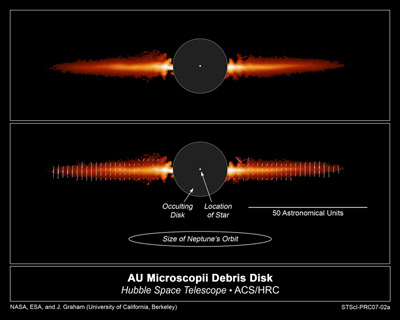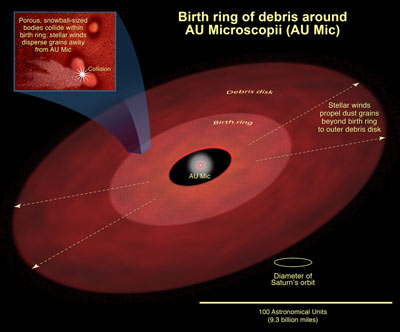|
It's the Astronomy Online non-Blog, or un-Blog.
Everyone has a blog now and since I am no follower of trends, I decided to merge the blog with the website. And I don't want to neglect the website in favor of posting on the blog.
These are the pages that were on the blog of old:
- Home
- Archive (Index of Pages)
- Me
- Current Trends
- Links
- Soho Live
Links:
Google Maps - Mars
Google Maps - Moon
HiRISE
HiRISE - MRO Imaging
Mac Singularity
Meade4M
Slackerpedia Galactica
Software for the Mac
Starry Night Online
Venus Maps
More Favorites:


































Thank you for visiting!
|
|
 |
|
Hubble Captures Earliest Stages of Planet Formation:
There is much we don't understand about planetary formation. There are images of proto-planetary disks and there are images of transiting exoplanets with nothing in between. What this Hubble image of AU Microscopii shows are dust particles emanating from collisions of snowball sized pre-planetesimal objects - the first image of planetary formation in process.
AU Microscopii, in the southern constellation Microscopus, is a Red Dwarf star 32 light years away. This type of star is the most abundant in our galaxy and offers the best laboratory for study of dusty planetary disks, because they are fainter and cooler than our Sun.

Using an occulting disk and polarized light, the Hubble Advanced Camera for Surveys was able to detect the dust which is about 10 times the size of interstellar dust grains.

While the presence of these dust particles is unexpected, it's possible these dust grains will eventually coalesce to form analogs of our own Kuiper Belt Objects. Stellar winds from the star blows the dust away from the birth ring to an area where this system's Kuiper Belt may form.
Project leader professor James Graham, University of California at Berkeley, says "circumstellar disks are thought to be vigorous, turbulent places. It is hard to understand why fluffy particles could grow and survive under such circumstances. But maybe there are some backwater places where turbulence had subsided and porous particles can form and grow. Planet-forming disks are undoubtedly much more complex than we currently envision."
The planets in our solar system lie inside the Kuiper Belt. Likewise, inside AU Microscopii's version of the Kuiper Belt is a gap that may have been carved out by one or more as-yet unseen planets.
Source: HubbleSite NewsCenter
Next Post | Previous Post | Back to Top
|
|

